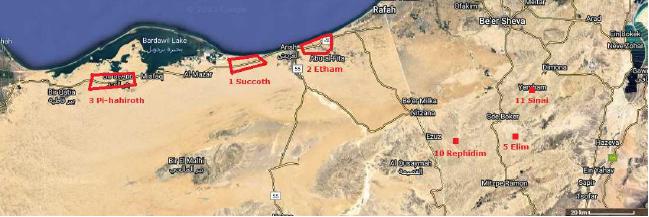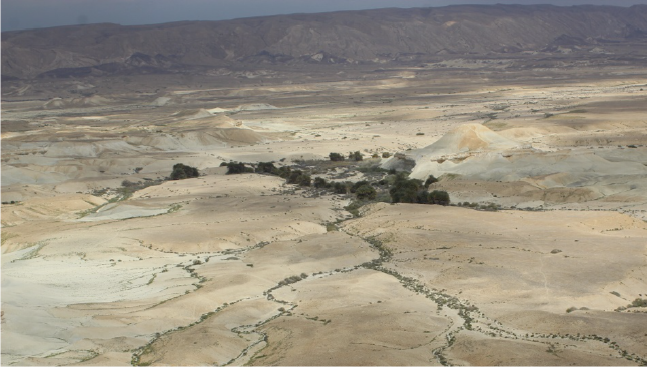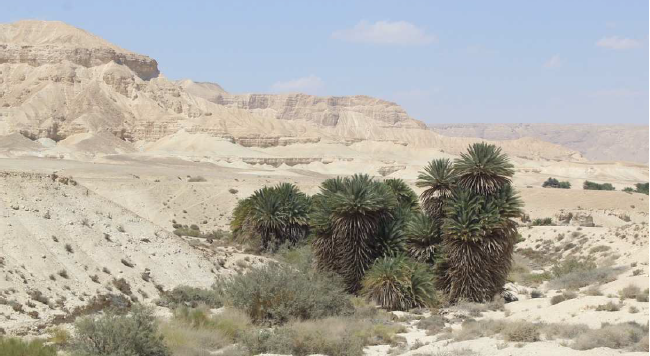
 | |
| Volume 13, Number 2 | February 16, 2023 |
A detailed itinerary of the encampments of the Israelites following their Exodus from Egypt is given in Numbers 33:1–49. The portion of this itinerary up to their encampment at Elim reads:
Then the sons of Israel journeyed from Rameses and camped in Succoth. They journeyed from Succoth and camped in Etham, which is on the edge of the wilderness. Then they journeyed from Etham and turned back to Pi-hahiroth, which faces Baal-zephon; and they camped before Migdol. They journeyed from Pi-hahiroth and passed through the midst of the sea to the wilderness; and they went three days' journey in the wilderness of Etham and camped at Marah. They journeyed from Marah and came to Elim; and in Elim there were twelve springs of water and seventy palm trees, and they camped there. (Numbers 33:5–9)
The descriptive details of Elim recited in Numbers 33 are corroborated in Exodus 15:27:
Then they came to Elim where there were twelve springs of water and seventy date palms, and they camped there beside the waters.
These biblical descriptions of Elim, though brief, are definitive of the site when coupled with what is currently known of the true route of the Exodus.
The initial route of the Exodus has previously been shown for the first three encampment sites: Succoth, Elam, and Pi-hahiroth.[1] Also shown and extensively reported on previously has been the location of Mount Sinai and of the Israelite encampment at Sinai on the plain to the east of the mountain.[2] Finally, the location of the encampment at Rephidim has been previously tentatively assigned.[3] The locations of these encampment sites, together with that of Elim, here identified for the first time, are shown on the Google Maps satellite view in Figure 1.
 |
The modern name of the Elim encampment site is Ein Zik (Figure 2). The identification of this site rests uniquely, not on professional archaeological excavations and publications, but rather on amateur descriptions and photos of it found on the Internet.
 |
Ein Zik is the only site in the Negev having natural (i.e., not introduced by humans in relatively modern times) date palms associated with it. The date palms found there are not a native Negev plant, and thus they are not expected to be found anywhere at all in the Negev.
The palm trees are not properly indigenous, someone planted them intentionally or dropped a date pip unintentionally no one knows how long ago and the conditions clearly favor them; measured in biomass it is by far the biggest oasis in the Negev Highland.[4]This explains why they are mentioned in the biblical narrative of the Exodus only in connection with Elim and not in connection with any of the other encampment sites. They were a novelty in the Negev back then, just as they are today.
The author of the Internet pages about Ein Zik, Marion Krivine, provides many fine, large, color photos embedded in helpful, informative commentary. I recommend them to you. Only three things need to be added here.
First, it appears that Middle Bronze Age I / Early Bronze Age IV / Intermediate Bronze Age (MBI-EBIV-IB—discussion of this nomenclature is planned for next issue) archaeological remains have been found in association with Ein Zik.
Ein Zik also has some history; the archaeologist Jacob Vardi wrote his masters thesis about the people who lived here in the Middle Bronze Age and the remains of their settlement are there for you to see, but no one can tell me exactly where and I haven't found it so far, perhaps you will have better luck.[5]
Evidence of MBI-EBIV-IB presence at Ein Zik is expected, of course, because the Israelites of the Exodus were the true MBI-EBIV-IB people, and it is impossible for two and a half million people to camp in the wilderness and leave no trace of their presence. Discarded fragments of broken pottery vessels seem to last about forever.
Second, Elim/Ein Zik shows that the Negev desert is more arid today than it was at the time of the Exodus.
Firstly it is an oasis with no surface water, no waterfall, no pool to cool your feet, nowhere for the kiddies to splash about.[6]This modern description contrasts with the ancient one quoted previously from Exodus 15:27.
Then they came to Elim where there were twelve springs of water and seventy date palms, and they camped there beside the waters.
This further corroborates the conclusion, discussed last issue,[7] that the climate in this region was less arid back at the time of the Exodus than it is today.
Third and final, there are more palm trees now than there were at the time of the Exodus (Figure 3).
 |
30 clusters of tall, robust palm trees (maybe 500 trees on total) but you can't get near them because their trunks are clogged with a mass of dead palm fronds and impenetrable undergrowth.[8]This allows a simple crude estimate to be made of the latest date when the initial seed may have been planted. There were 70 palms 2447 B.C. There are roughly 500 palms today, 2023 A.D. Extrapolating linearly yields (500 - 70=) 430 new trees in (2450 + 2022=) 4472 years. So 70 palms would take (70/430 × 4472 =) 728 years. Thus, the latest date for the planting of the first tree would be (2447 + 728 =) 3175 B.C.
This date will be too late because populations grow exponentially, not linearly. We need three observations of the number of trees at different times to extrapolate exponentially, and we have only two, so linear extrapolation is the best we can do. Exponential growth would extrapolate the planting date more remotely into the past, so the true planting date is strictly (and probably considerably) more ancient than 3175 B.C.
Correlating this with biblical history suggests the possibility that the origin of this date palm grove coincides with the Flood of Noah, which happened 3520 B.C.[9] It is possible that the initial date palm seed(s) may have been carried to this spot among floating debris as the Flood waters subsided. ◇
The Biblical Chronologist is written and edited by Gerald E. Aardsma, a Ph.D. scientist (nuclear physics) with special background in radioisotopic dating methods such as radiocarbon. The Biblical Chronologist has a fourfold purpose: to encourage, enrich, and strengthen the faith of conservative Christians through instruction in biblical chronology and its many implications, to foster informed, up-to-date, scholarly research in this vital field, to communicate current developments and discoveries stemming from biblical chronology in an easily understood manner, and to advance the growth of knowledge via a proper integration of ancient biblical and modern scientific data and ideas. The Biblical Chronologist (ISSN 1081-762X) is published by: Aardsma Research & Publishing Copyright © 2023 by Aardsma Research & Publishing. Scripture quotations taken from the (NASB®) New American Standard Bible®, Copyright© 1960, 1971, 1977, 1995 by The Lockman Foundation. Used by permission. All rights reserved. www.Lockman.org |
^ Gerald E. Aardsma, "The Route of the Exodus," The Biblical Chronologist 2.1 (January/February 1996): 1–9. www.BiblicalChronologist.org. Gerald E. Aardsma, The Exodus Happened 2450 B.C. (Loda, IL: Aardsma Research and Publishing, 2008). www.BiblicalChronologist.org. Gerald E. Aardsma, "The Route of the Exodus, Part II: The Encampment at Etham," The Biblical Chronologist 13.1 (February 7, 2023): 1–5. www.BiblicalChronologist.org.
^ Gerald E. Aardsma, "Yeroham—The True Mt. Sinai?" The Biblical Chronologist 1.6 (November/December 1995): 1–8. www.BiblicalChronologist.org. Gerald E. Aardsma, "The Bamah of Moses at Mount Sinai," The Biblical Chronologist 6.3 (May/June 2000): 1–10. www.BiblicalChronologist.org. Gerald E. Aardsma, "Yeroham: the True Mount Sinai," The Biblical Chronologist 6.4 (July/August 2000): 1–11. www.BiblicalChronologist.org. Gerald E. Aardsma, "Report on the Excursion to Mt. Yeroham – Part I," The Biblical Chronologist 6.5 (September/October 2000): 1–13. www.BiblicalChronologist.org. Gerald E. Aardsma, "Report on the Excursion to Mt. Yeroham – Part II," The Biblical Chronologist 6.6 (November/December 2000): 1–10. www.BiblicalChronologist.org. Gerald E. Aardsma, "Report on the Excursion to Mt. Yeroham – Part III," The Biblical Chronologist 7.1 (January/February 2001): 1–16. www.BiblicalChronologist.org.
^ Gerald E. Aardsma, "Yeroham—The True Mt. Sinai?" The Biblical Chronologist 1.6 (November/December 1995): 8. www.BiblicalChronologist.org. Gerald E. Aardsma, "The Bamah of Moses at Mount Sinai," The Biblical Chronologist 6.3 (May/June 2000): 7. www.BiblicalChronologist.org.
^ Marion Krivine, visitingnegev.com/ein-zik-and-ein-shaviv/#more-3159 (accessed January 24, 2023).
^ Marion Krivine, visitingnegev.com/ein-zik-and-ein-shaviv/#more-3159 (accessed January 24, 2023).
^ Marion Krivine, visitingnegev.com/ein-zik-and-ein-shaviv/#more-3159 (accessed January 24, 2023).
^ Gerald E. Aardsma, "The Route of the Exodus, Part II: The Encampment at Etham," The Biblical Chronologist 13.1 (February 7, 2023): 1–5. www.BiblicalChronologist.org.
^ Marion Krivine, visitingnegev.com/ein-zik-and-ein-shaviv/#more-3159 (accessed January 24, 2023).
^ Gerald E. Aardsma, Noah's Flood Happened 3520 B.C. (Loda, IL: Aardsma Research and Publishing, 2015). www.BiblicalChronologist.org.